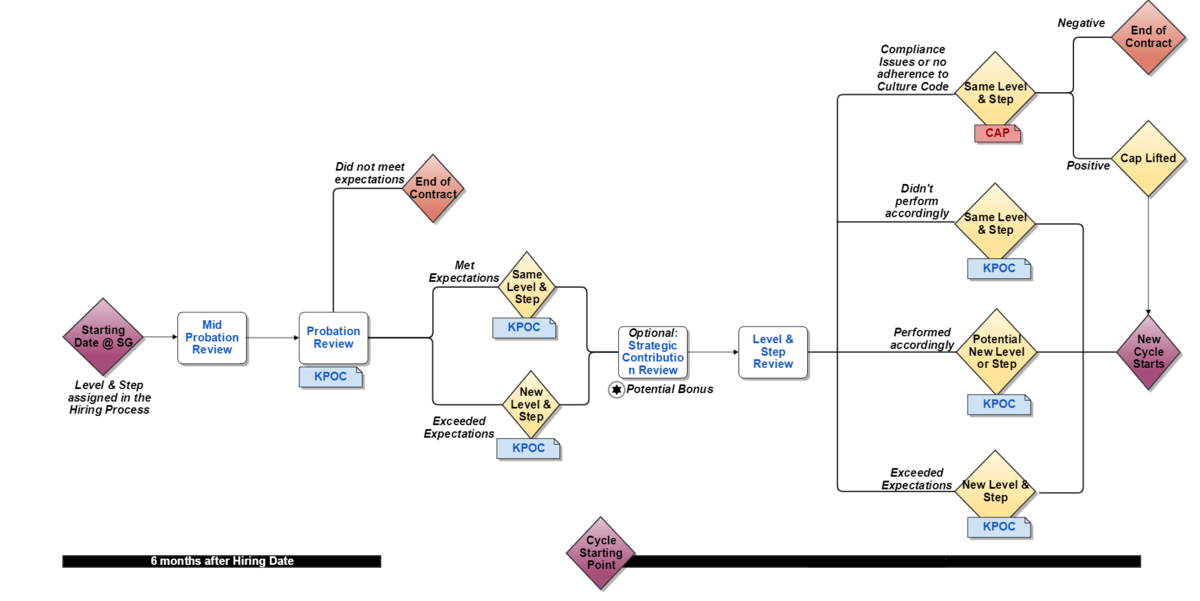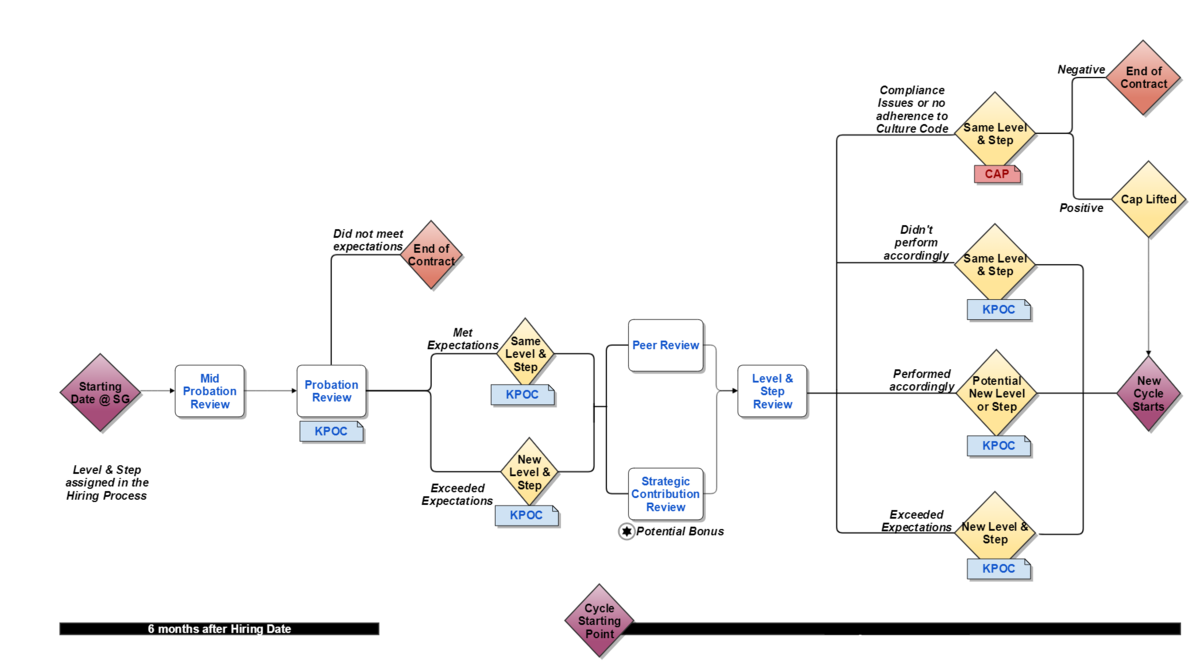| Levels Chart
|
| Management Path
|
Level 1
|
Level 2
|
Level 3
|
Level 4
|
Level 5
|
Level 6
|
| Trainee
|
Coordinator
|
Manager
|
Sr. Manager
|
Head of
|
Director
|
| Scope (based on the RACI, Internal Rules, Management Model & Balanced Scorecard)
|
Receives assignments in the form of objectives with goals and instructions to contribute in some part of the department process.
|
Receives assignments in the form of objectives with goals and instructions on the process for meeting goals. Manages a wide range of processes.
|
Receives assignments in the form of objectives with goals and instructions on the process for meeting goals. Management reviews work to measure the meeting of objectives. Establishes and maintains the department's strategy.
|
Receives assignments in the form of objectives and determines how to use resources to meet schedules and goals. Senior management reviews objectives proposed by Heads to determine the success of the operation. Focuses on strategic goals.
|
Establishes objectives and work plans and delegates assignments to subordinates.
|
Participates with other senior managers to establish strategic plans and objectives.
|
| Understands established policies from Secure Group.
|
May provide directions to employees according to established policies. Administers company policies that could affect employees from the same department. Plan, direct and coordinate the departments' policies.
|
Provides direction to employees according to established policies and management guidance. Administers company policies that directly affect subordinate employees or individual contributors.
|
Guides subordinates within the latitude of established company policies.
|
It is involved in developing, modifying and executing company policies that affect immediate operations and may also have company-wide effect.
|
Makes final decisions on administrative or operational matters and ensures goals are met through operational efficiency.
|
| Understands his/her Framework and the specifications to Level Up & Step Up
|
May provide directions to employees according to the criterias of their framework in order to achieve a higher level.
|
Provides direction and guidance to employees according to their framework. Administers the KAI assessment that directly affects their department or individual contributors.
|
Guides subordinates within the criterias of their framework. Acts as a ambassador of the Career Framework and it's capable of understanding the other's departments Frameworks.
|
It is involved in developing and modifying frameworks that affect our business in a company-wide effect. Acts as a spokesperson for Secure Group Management Model.
|
Makes final decisions on strategic matters and ensures business goals are met through the effective application of the Management Model.
|
| Is informed about Secure Group Strategic Map & overall Strategy.
* In Practice: The employee knows there's a Strategic Map for the company and by department.
|
Knows how to explain the overall strategy shown in the Strategic Maps from both Secure Group and relevant department.
* In Practice: The employee knows the business goals and the main KPIs and Initiatives to reach them.
|
Understands Secure Group's strategy and contributes effectively to the business' goals in it.
* In Practice: the employee knows exactly which KPIs and Initiatives are being tracked in order to reach complete the business goals shown in the Strategic Map of their department and can direct the tasks/projects to accomplish them.
|
Can easily explain Secure Group's strategies as part of his day-to-day job and acts like an owner of the business' goals.
* In Practice: the employee is the owner of KPIs and some Initiatives from their department's Strategic Map, contributes to the business goals and can easily understand how it all relates to Secure Group overall strategy
|
Has a deep understanding of Secure Group's strategy and it's directly responsible for achieving one or more business' goals.
* In Practice: the employee is the owner of a significant number of Initiatives in their department, it's completely responsible for achieving goals in their department and contributes directly to one or more business goals from Secure Group Strategic Map.
|
Acts like a spokesperson for Secure Group Strategic Plan, market space, and products and has a thorough, holistic understanding of the business.
* In Practice: the employee is responsible for achieving a significant amount of business goals from Secure Group General Strategic Map. It's usually the owner of a whole Strategic Theme.
|
| Complexity
|
Works on issues to acquire enough data for peers to analyze relevant factors.
|
Works on issues where analysis of situation or data requires a review of relevant factors.
|
Works on issues where analysis of situation or data requires a review of relevant factors.
|
Works on issues of diverse scope where analysis of situation or data requires evaluation of a variety of factors, including an understanding of current business trends.
|
Works on issues where analysis of situations or data requires an in-depth knowledge of organizational objectives.
|
Works on complex issues where analysis of situations or data requires an in-depth knowledge of the company.
|
| Participates in the decision-making process by suggesting improvements.
|
It is involved in defining procedures and policies to determine appropriate action.
|
Exercises judgment within defined procedures and policies to determine appropriate action.
|
Follows processes and operational policies in selecting methods and techniques for obtaining solutions. Acts as an advisor to subordinate(s) to meet schedules and/or resolve technical problems. Develops and administers schedules and performance requirements.
|
Implements strategic policies when selecting methods, techniques, and evaluation criteria for obtaining results. Establishes and assures adherence to budgets, schedules, work plans, and performance requirements.
|
Participates in corporate development of methods, techniques and evaluation criteria for projects, programs, and people. Ensures that budget needs and corporate requirements are met.
|
| Discretion
|
Erroneous decisions or failure to achieve results might cause delays in schedules and may impact the projects of the department.
|
Erroneous decisions or failure to achieve results might cause delays in schedules and may impact the projects of the department.
|
Erroneous decisions or failure to achieve results will cause delays in schedules and may impact the projects of Secure Group.
|
Erroneous decisions or failure to achieve results will add to costs and may impact the short-term goals of the organization.
|
Erroneous decisions will result in critical delay(s) in schedules and/or operations and may jeopardize overall business activities.
|
Erroneous decisions will have a serious impact on the overall success of the company in reaching its strategic goals and will affect operations.
|
| Knowledge Sharing
|
You attend tech-sessions that were assigned to you
|
You support the creation of content and/or you give Tech-Sessions that are related to the application of tools within a defined process and processess in general.
|
You ensure there's no knowledge gap in your team and you assess the Tech-Sessions given by others through your subordinates KAI. You give Tech-Sessions that are related to concepts.
|
You create content and/or give Tech-Sessions related to our business: models, frameworks etc.
|
You identify knowledge GAP from internal references and create relevant content to be applied in Tech-Sessions.
|
You identify knowledge gaps from external references and create relevant content to be applied in Tech-Sessions.
|
| Collaboration
|
You support collaboration.
|
You encourage others to collaborate.
|
You drive collaboration efforts within the team acting as a mediator.
|
You mobilize others by creating procedures, providing context and the necessary tools to enable collaboration.
|
You identify strategic collaboration opportunities inside the company and lead the efforts between teams to ensure high-performance.
|
You identify external opportunities and instill a culture based in collaboration.
|
| Interaction
|
Frequently interacts with coordinators and functional peer groups.
|
Frequently interacts with managers and functional peer groups.
|
Frequently interacts with subordinate coordinators and individual contributors.
|
Frequently interacts with subordinates, customers, and/or functional peer group managers, usually involving matters regarding functional areas or relationships between customers and the company.
|
Regularly interacts with senior management or executive levels on matters concerning several functional areas, divisions, and/or customers.
|
Regularly interacts with executives and/or major customers.
|
| Interaction usually requires the ability to understand the department's needs and cooperate with others, researching insights and materials for presentations of technical information concerning specific projects or schedules. Builds stable working relationships internally.
|
Interaction normally requires the ability to gain the cooperation of others, conducting presentations of technical information concerning specific projects or schedules. Builds stable working relationships internally.
|
Interaction normally requires the ability to gain the cooperation of others, conducting presentations of technical information concerning specific projects or schedules.
|
Interaction must often lead to a cooperative effort among members of a project team.
|
Interaction requires the ability to change the thinking of, or gain acceptance from, others in sensitive situations, without damage to the relationship.
|
Interaction frequently involve special skills, such as negotiating with customers or management or attempting to influence senior level leaders regarding matters of significance to the organization.
|
| Supervision
|
Doesn't provide direct supervision to professionals. Acts as a consultant to unit or sub-units and may become actively involved, as required, to meet schedules and help other managers in resolving problems. Usually receives detailed instructions on different tasks.
|
Doesn't provide direct supervision to professionals. Acts as an advisor to trainees and lower levels and may become actively involved, as required, to meet schedules and help managers in resolving problems.Frequently receives general instructions on different tasks.
|
Provides direct supervision and support to individual contributors (e.g., engineers, designers, developers).
Acts as advisor to unit or sub-units and may become actively involved, as required, to meet schedules and resolve problems.
|
Manages, the coordination of the activities of a section or department with responsibility for results, including costs, methods, and staffing.
|
Manages activities of two or more sections or departments. Exercises supervision in terms of costs, methods, and staffing.
|
Directs and controls the activities of a broad functional area through several department managers within the company. Has overall control of planning, staffing, budgeting, managing expense priorities, and recommending and implementing changes to methods. May manage other managers.
|
| Learnability
|
Studies new concepts and is open to the mindset of learning new methodologies.
|
Constantly acquires knowledge applicable on a daily basis in certain projects.
|
Continuously learns new concepts and methodologies that will be essential to improve processes and projects within the department.
|
Capable of mapping and understanding which knowledge is missing to achieve Secure Group business goals in different departments and self-learn a variety of them.
|
Constantly strives to learn new subjects related to Secure Group strategic plan and the industry and has the credibility to pass the knowledge to the rest of the company.
|
Totally masters the self-learnability mindset, studies a variety of topics related to strategy, business, industry, market, and technologies.
|

